Comfort Gloop: The Textural Reassurance of Pimento Cheese
Cheese Sandwich Month is technically behind us, but, hey—don’t be so quick to rush off. Listen: let’s talk about pimento cheese.
I could set out to demystify pimento cheese for the uninitiated, but there’s nothing particularly mystical about it. I love the stuff, but I’m not going to pretend it’s anything other than a viscid gunk—a crudely-composed, fat-laden discharge of humble orange-colored mayo-cheese ooze. And I mean that as a compliment. The pasty texture of pimento cheese is simultaneously grainy and gloopy, like wet adobe, like something you could fashion into crude bricks and bake under a desert sun before assembling a shelter that reeks of cheddar and adequacy. Just to be totally real with you, if I were from another part of the country and encountered the stuff for the first time, I’d probably find it pretty gross. But I’m from the South, and it’s like home to me.
So, some context:
Not long ago, I huddled over my computer and read Emily Elizabeth Wallace’s excellent 2010 Master’s thesis on pimento cheese. Some of what I learned didn’t surprise me. For starters, North Carolina apparently consumes more pimento cheese than any other state. Its two largest cities, Charlotte and Raleigh, comprise the nation’s two largest markets for the spreadable cheese gunk. The commercial pimento cheese industry largely began as an outgrowth of the textile industry that once dominated the central portion of the state. Commissaries—tasked with feeding the tens of thousands of mill workers who toiled in the hot, loud hosiery mills and linen factories of the North Carolina Piedmont—began to contract with area food companies to produce cheap, easy-to-eat lunches that could quickly feed an employee who wasn’t permitted to take a conventional lunch break. Pimento cheese sandwiches were a quick convenience food that met all of these criteria, cementing their cultural legacy as a working class delicacy. As the decades passed, the textile factories of the Piedmont were boarded up, demolished or turned into high-ceiling loft apartments for carpetbagging yuppies from the North. The mill jobs evaporated, but the pimento cheese—gooey, pasty and somehow simultaneously both inelegant and graceful—remained.
All of this makes sense to me. I grew up in Charlotte, and pimento cheese sandwiches were one of the few constant threads of a tumultuous childhood. I ate them at home, I ate them at my friends’ houses, I packed them for lunch in middle and high schools. For someone who lived in seven different places between 1st and 11th grades, pimento cheese sandwiches were something persistent and unchanging for a kid whose scenery, neighborhoods, schools and friends were constantly being uprooted and replaced by the unfamiliar. Pimento cheese was a faithful, easy-to-get-along-with companion. It abhorred extremes, especially the mild-mannered commercial brands like Star and Stan’s. It was mildly cheddary, mildly creamy, mildly sweet and mildly spicy. It was inoffensive. Gentle, even. For me, pimento cheese was the closest to pure comfort food as anything ever got.
Anyway. If you’re a non-Southerner, you may have heard of pimento cheese via its regrettable association with The Masters, a.k.a the Gamergate of sporting events, that venerable white power rally/Foghorn Leghorn Impersonator Summit masquerading as a golf tournament. Or maybe you’ve learned about pimento cheese from disgraced antebellum fetishist Paula Deen, who is what would happen if The Masters somehow acquired human form and immediately enrolled in clown correspondence college. Point being, you shouldn’t pay attention to anything that comes out of Georgia unless it’s Vidalia onions or hip hop; those two wonderful things notwithstanding, Georgia is little more than a vast humid wasteland of plantation nostalgia, Leviticus 18:22 fandom and Mama’s Family cosplay. I’m not saying North Carolina isn’t without its share of problems; I’m just saying Georgia is the worst place on Earth that isn’t yet directly controlled by ISIS. But, back on topic.
I won’t tell you how to make pimento cheese. I’m not trying to be proprietary; it’s just that A) there’s nothing particularly technical about tossing a heap of grated and diced ingredients into a bowl before gluing them together with mayonnaise and B) like most spread-like mixtures, pimento cheese is something that ought to be calibrated to one’s personal taste. But, okay. I will say that I usually begin by grating an 8 oz block of sharp cheddar along with half a block of Cabot hot habanero cheese. Then I dump the thicket of grated cheeses into a bowl and toss in four ounces of (drained) sliced or diced jarred pimentos along with half of a diced Vidalia onion. Next, I chuck in a tablespoon of prepared horseradish, then dribble a half-dozen drops each of Texas Pete and Worcestershire sauce. Finally, the all-too-crucial binding agent: roughly half a 16 oz jar of Duke’s mayonnaise. Duke’s. Not Hellmann’s, and definitely not Miracle Whip, that dogshit fusion of high fructose corn syrup and corn starch which ranks—after the 1962 Cubs—as the second-worst thing to ever come out of Chicago. Nope. Duke’s.
Fabricating your own recipe for pimento cheese should be a matter of personal creative expression and improvisation, but let’s get real about one thing: the inclusion of Duke’s mayonnaise is non-negotiable. While Duke’s certainly deserves its own effusive screeds (of which there are plenty on the internet), it may not be immediately obvious to newcomers why it’s inspired such a fanatical following in the South. There’s something old-fashioned, even dowdy about the way it looks and tastes. Like a decorum-obsessed South-of-Broad matriarch, Duke’s goes out of its way to be inoffensive. Unlike Hellmann’s, it doesn’t contain sugar, lending it a subdued, delicate flavor that makes Duke’s an ideal base for everything from cole slaw (you know, to stack atop the pile of pig meat on your Carolina-style pulled pork sandwich) to homemade salad dressings to (naturally) pimento cheese. And I swear I’m not getting paid to write this shit, either. Just trust me on the Duke’s thing.
Moving beyond mayonnaise, the lanes for experimentation open up considerably. Want to introduce some Dijon mustard to your gluey cheese-mayo glop? Go right ahead. Want to splash x hot sauce or hurl y chopped herb into that shimmering glutinous mass? Let’s get nuts. No matter what you toss in, the main thing is to mix the living hell out of it and try to achieve as even a consistency as possible. But try to keep within the confines of lucid reason and wholesome propriety. I’ve seen pimento cheese recipes that called for ancho chiles and fresh-ground cumin; at that point you may as well toss in a can of Ro*Tel and make queso, you junior grade Bobby Flay motherfucker. Tex-Mex is not the flavor profile we’re striving for here, people. Other pigheaded recipes suggest substituting roasted red peppers for the humble diced pimento. I mean, authenticity is a fake, fanciful conceit, but the textile mill food carts that peddled sandwiches to your sweaty, underpaid grandmothers and grandfathers sure as hell weren’t roasting red peppers for their humble cheese-spooge. Show some goddamn respect to your forebears, buy a jar of pimentos and save the roasted red peppers for your marinara sauce.
Back to you, your mixing bowl, and your nascent cheesy ectoplasm. Ingredient ratios are a matter of preference. You’ll find recipes that call for a couple of tablespoons of mayonnaise and others that demand a cup or more. For your homemade pimento cheese, the amount of mayo you use is purely about textural calibration, i.e. where along the continuum between solid and liquid do you wish to plot your gluey sandwich spread. Don’t worry, there’s no definitive answer. I like my pimento cheese right down the middle: spreadable but not overly smooth, a consistency that’s a little coarse and grainy when chilled but turns more viscous when heated up.
Which, speaking of. A cold or room-temperature pimento cheese sandwich is a great thing—because pimento cheese is great—but a grilled or hot pimento cheese sandwich is even better. If you make pimento cheese the way I like to make it, something wonderful happens when you fashion it into a hot sandwich. You slice apart a chunk of Italian bread, toast the halves face-down on a skillet, then glue the halves back together with some pimento cheese (which gets warmed up by the toasted bread). Or maybe you take two slices of ordinary sandwich bread, bind them with a thin layer of pimento cheese, then grill the thing on a skillet, making sure to get both sides nice and crispy-brown.
You sit down; you take your first bite. If you make pimento cheese the way I like to make it, your mouth is treated to a triptych of three distinct yet interdependent sensations. First comes the mild sweetness of pimento peppers drifting along a warm, genial blanket of cheddar. A second later, you taste the subdued spice of chopped Vidalia onions and the muted tang of horseradish. Remember that hot Habanero cheese you chucked in? It arrives last, cresting with the hot sauce to paint a bright burst of vivid heat across your tongue. You reach for your bottle of Cheerwine (just as your ancestors did), you take a sip, you cleanse your palate, you rinse, you repeat. Sweet-tangy-hot. 1-2-3. Nothing particularly mystical about it. It’s just gloop. But you love the stuff.
I’m a seafood-obsessed environmental scientist from North Carolina currently enduring the pain of living in a landlocked state. I spend most of my free time thinking about baseball, history, Shaw Bros. movies and weird synthesizer music.


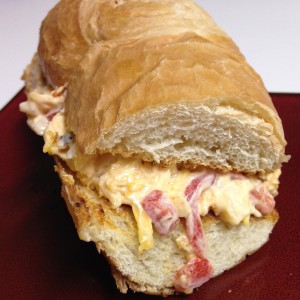
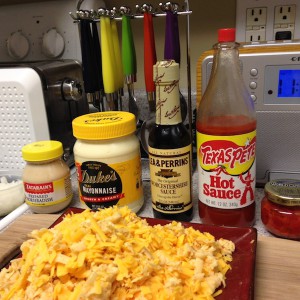
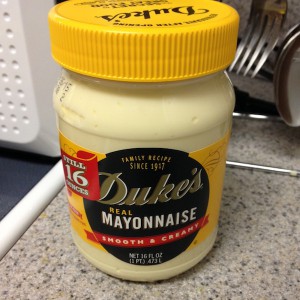
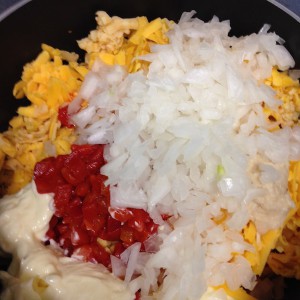

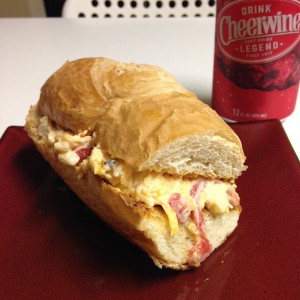

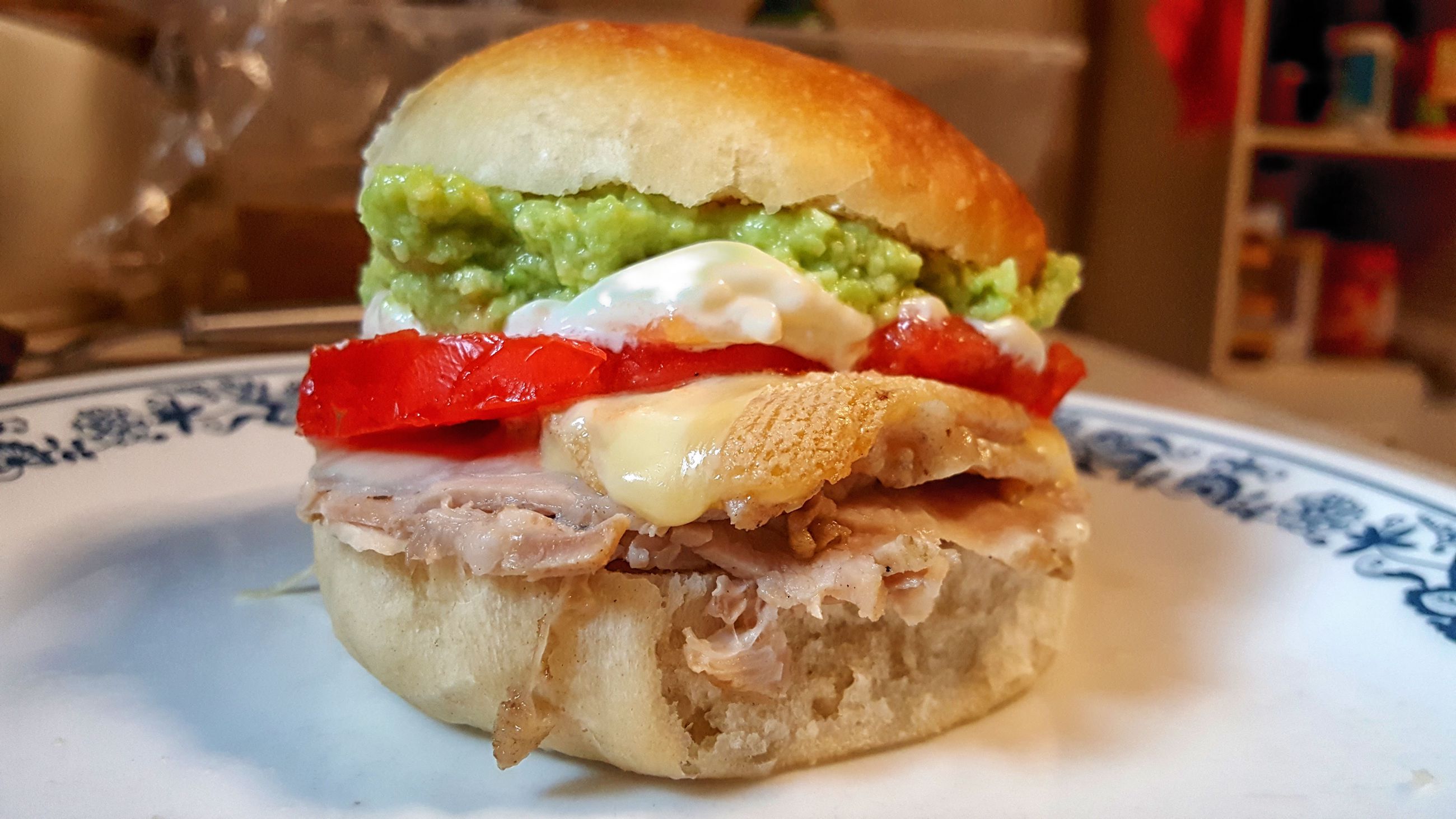







According to their store locator, Duke’s Mayonnaise is available in Illinois, so I’ll be looking for it ASAP to try making this. Amazing post, Thom! Better late than never 😉
This is a great goddamn post even if I am totally opposed to the entire concept of pimento cheese. Sorry dude, but blech!
I enjoyed reading this article immensly.
This is an awesome article. I have just discovered pimento cheese about a month and a half ago and I read this while…eating pimento cheese. Not a sandwich though. With pretzels.